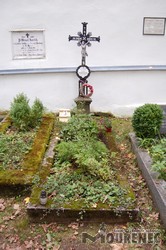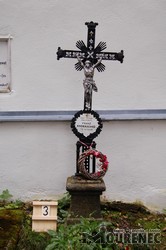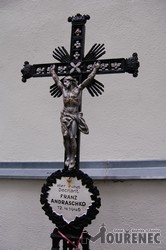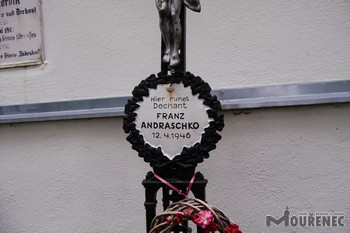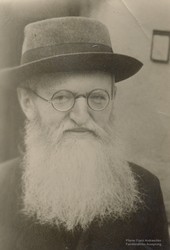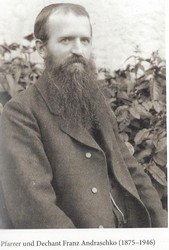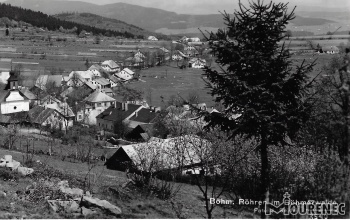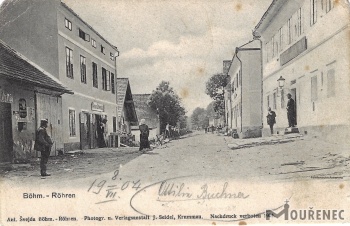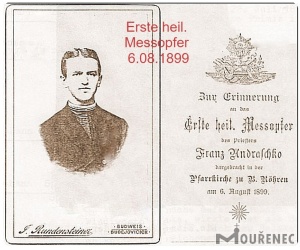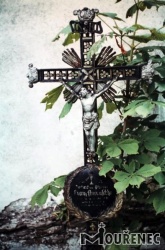Grave number : 3 |
||||
| Show the location of the grave on the cemetery map | ||||
Last name Name, Other informations | ||||
| Andraschko Franz, Dean Franz, born in České Žleby, St. Maurenzen, (Svatý Mouřenec) , * 22.01.1875, † 12.04.1946 | ||||
Information about the grave | ||||
| Edging of the grave : | stone | |||
| Pedestal of the cross : | stone | |||
| Cross : | metal whole - repaired | |||
| Inscription : | metal sign on the cross | |||
Links to sources of further information | ||||
| Franz Andraschko - Přátelé Mouřence | ||||
| Dean Franz Andraschko - maurenzen.de | ||||
| Wikipedia CS | ||||
| Kohoutí kříž - South Bohemian Scientific Library in České Budějovice | ||||
| Kohoutí kříž - South Bohemian Scientific Library in České Budějovice - Photos | ||||
| kaplicky.cesty.in | ||||
| Disappeared Šumava - Stream - Video | ||||
Comment | ||||
| • | Franz Andraschko came from a simple Šumava rural family from České Žleby (then Böhmisch Röhren). His parents managed a small farmstead in solitude on Krásná Hora near České Žleby. Franz studied theology at a seminary in České Budějovice and in 1899 he was ordained a priest by the Bishop of České Budějovice, Martin Josef Říha. However, he had to receive a dispensation to receive the ordination because he had limited one-handed momentum. Franz's younger brother Johannes also received priestly ordination in 1901 (he served the primary Holy Mass in České Žleby on August 4, 1901), who, however, soon began working as a priest and catechist in Vienna. The sister of the two priests' brothers, Anna, went with Johannes to Austria and ran his household. Priesthood Franz Andraschko joined the parish of Mouřenec from the autumn of 1899 as a chaplain. With this place, despite the harsh local living conditions (and the fact that he himself was relatively delicate and cold-tempered), he connected the rest of his life. In 1902, the current pastor Alois Winter resigned from the mourning benefit and Franz Andraschko was appointed in his place. He devoted himself to his priestly ministry, was popular among parishioners, and was also known for his special humor. He was known as a man prone to disease, strict but at the same time cordial. Over time, he became an almost legendary character. He supported poor families in his parish and it is said that every Sunday he invited one of the poor to his parish for lunch. He also took great care of the sick, notwithstanding his own health. The bishop of České Budějovice praised his work by awarding the title of dean ad personam. In 1908 he got into a dispute with the owner of the castle in Kundratice, which belongs to the territory of the Mourenice parish. This owner of the castle was Protestant and allowed non-Catholic services in the Catholic castle chapel without asking the church authorities for consent. Andraschko announced his activities to his superior, the Archdeacon in Kašperské Hory, and the matter was referred to the consistory of České Budějovice. Non-Catholic services had to cease and the chateau chapel was consecrated again. However, Andraschko was then dragged by the non-Catholic press and had to defend himself by a written statement published in the newspaper. He also emphasized that suicides did not have the right to a church funeral at the time, which led suicide survivors to that they had agreed with the relevant doctor, and he had variously camouflaged suicides in reports to the parish office so that the pastor would not look for the real cause of death and bury the suicides. Andraschko later inspected this, but adhered to official announcements. He then actually buried the suicide, but later told the bereaved that he knew about this circumvention of church regulations. During the First World War, he managed to save the oldest church bell from Mournice from 1329 from the requisition. So did during the Second War. Gradually, however, his already fragile health deteriorated. From 1943, he had to stop teaching religion in person, as he could no longer make the journey from the solitary confinement to the parish schools. In 1944, he was assisted by a chaplain, R.D. Johann Landwehr, part of the Schönstatt movement. Andraschko, despite his deteriorating health, persistently refused transportation to the hospital, where he could be better cared for. After the end of the war, he was included among the Germans destined for deportation, and his health continued to deteriorate sharply. He died at the parish church on March 12, 1946, before his removal was carried out. He was buried in the Mournice cemetery near the parish church. He was the last settlement clergyman at Mouřenec. His chaplain also had to leave Mouřenec. The local parish began to decline after Andraschk's death, and the gradual devastation continued until the early 1990s. source: cs.wikipedia.org | |||
Photos of the grave | ||||
|
